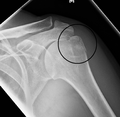Humerus fracture: Difference between revisions
m imaging |
mNo edit summary |
||
| Line 18: | Line 18: | ||
Certain [[lesions]] are commonly associated with [[fracture]]s to specific areas of the humerus. At the upper end, the [[surgical neck of the humerus]]<ref>{{cite web |url=http://www.wheelessonline.com/ortho/surgical_neck_fractures_of_the_humerus |title=Surgical Neck Fractures of the Humerus - Wheeless' Textbook of Orthopaedics |accessdate=2007-08-16 |format= |work=}}</ref> and [[anatomical neck of humerus]]<ref>{{cite web |url=http://www.wheelessonline.com/ortho/anatomic_neck_fracture_of_humerus |title=Anatomic Neck Fracture of Humerus - Wheeless' Textbook of Orthopaedics |accessdate=2007-08-16 |format= |work=}}</ref> can both be involved, though fractures of the surgical neck are more common. The [[axillary nerve]] can be damaged in fractures of this type. Mid-shaft fractures may damage the [[radial nerve]], which traverses the lateral aspect of the humerus closely associated with the [[radial groove]]. The [[median nerve]] is vulnerable to damage in the supracondylar area, and the [[ulnar nerve]] is vulnerable near the [[medial epicondyle of the humerus|medial epicondyle]], around which it curves to enter the forearm. |
Certain [[lesions]] are commonly associated with [[fracture]]s to specific areas of the humerus. At the upper end, the [[surgical neck of the humerus]]<ref>{{cite web |url=http://www.wheelessonline.com/ortho/surgical_neck_fractures_of_the_humerus |title=Surgical Neck Fractures of the Humerus - Wheeless' Textbook of Orthopaedics |accessdate=2007-08-16 |format= |work=}}</ref> and [[anatomical neck of humerus]]<ref>{{cite web |url=http://www.wheelessonline.com/ortho/anatomic_neck_fracture_of_humerus |title=Anatomic Neck Fracture of Humerus - Wheeless' Textbook of Orthopaedics |accessdate=2007-08-16 |format= |work=}}</ref> can both be involved, though fractures of the surgical neck are more common. The [[axillary nerve]] can be damaged in fractures of this type. Mid-shaft fractures may damage the [[radial nerve]], which traverses the lateral aspect of the humerus closely associated with the [[radial groove]]. The [[median nerve]] is vulnerable to damage in the supracondylar area, and the [[ulnar nerve]] is vulnerable near the [[medial epicondyle of the humerus|medial epicondyle]], around which it curves to enter the forearm. |
||
Radiographs are usually considered as a first-line imaging modality to evaluate clinically suspected humerus fracture. [[Medical ultrasound|US]], [[ |
Radiographs are usually considered as a first-line imaging modality to evaluate clinically suspected humerus fracture. [[Medical ultrasound|US]], [[Magnetic resonance imaging|MRI]], and [[X-ray computed tomography|CT]] are adequate alternatives if radiographs fail to demonstrate the cause of symptoms or do not sufficiently delineate the fracture for management purposes. CT is currently considered the gold standard to diagnose, but has limitations to detect adjacent soft tissue disorders. Depiction of greater tuberosity fractures at US is not uncommon in trauma setting because the fracture may be missed or overlooked at baseline radiographs and the patient will then present for US to scan rotator cuff for abnormalities.<ref>Arend CF. Ultrasound of the Shoulder. Master Medical Books, 2013. Chapter on humerus fracture available at [http://www.shoulderus.com/ultrasound-of-the-shoulder/shoulder-fracture-spectrum-of-ultrasound-findings/ ShoulderUS.com]</ref> |
||
<gallery> |
<gallery> |
||
File:GreatertrochanerAP.png|A fracture of the greater tuberosity as seen on AP X ray |
File:GreatertrochanerAP.png|A fracture of the greater tuberosity as seen on AP X ray |
||
Revision as of 12:46, 5 September 2013
| Humerus fracture |
|---|
A humerus fracture can be classified by the location of the humerus involved: the upper end, the shaft, or the lower end.
Certain lesions are commonly associated with fractures to specific areas of the humerus. At the upper end, the surgical neck of the humerus[1] and anatomical neck of humerus[2] can both be involved, though fractures of the surgical neck are more common. The axillary nerve can be damaged in fractures of this type. Mid-shaft fractures may damage the radial nerve, which traverses the lateral aspect of the humerus closely associated with the radial groove. The median nerve is vulnerable to damage in the supracondylar area, and the ulnar nerve is vulnerable near the medial epicondyle, around which it curves to enter the forearm.
Radiographs are usually considered as a first-line imaging modality to evaluate clinically suspected humerus fracture. US, MRI, and CT are adequate alternatives if radiographs fail to demonstrate the cause of symptoms or do not sufficiently delineate the fracture for management purposes. CT is currently considered the gold standard to diagnose, but has limitations to detect adjacent soft tissue disorders. Depiction of greater tuberosity fractures at US is not uncommon in trauma setting because the fracture may be missed or overlooked at baseline radiographs and the patient will then present for US to scan rotator cuff for abnormalities.[3]
-
A fracture of the greater tuberosity as seen on AP X ray
-
A fracture of the greater tuberosity of the humerus
-
Fracture of the greater tuberosity of the humerus
-
Proximal humerus fracture
See also
References
- ^ "Surgical Neck Fractures of the Humerus - Wheeless' Textbook of Orthopaedics". Retrieved 2007-08-16.
- ^ "Anatomic Neck Fracture of Humerus - Wheeless' Textbook of Orthopaedics". Retrieved 2007-08-16.
- ^ Arend CF. Ultrasound of the Shoulder. Master Medical Books, 2013. Chapter on humerus fracture available at ShoulderUS.com




